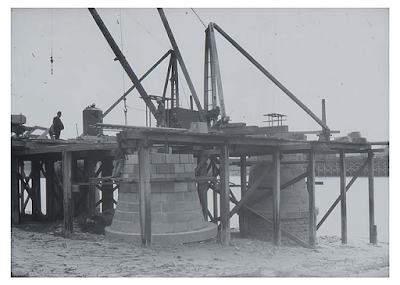The Development of Newport Docks
The Development of Newport Docks
Newport Museum and Art Gallery, closed at the moment, had a photographic exhibition about the development of Newport Docks.
| The Newport Transporter Bridge under construction, 7 June 1903 |
The Newport Ship
Newport's riverside wharves and jetties have existed at this major trading port since at least the fifteenth century, as evidenced by the discovery of The Newport Ship trading vessel dating from 1465-6. See David Jordan's painting below.
 |
| Approaching Newport” by David Jordan |
The Monmouthshire Canal
 |
| The Town Dock, a sketch by J F Mullock, circa 1842 Newport Museum and Art Gallery |
 | |||
|
The Wharfs
In 1835 the banks of the Usk at Newport had wharfs where goods were offloaded and uploaded. The tidal range at Newport in the city centre rises and falls more than any other river in any city centre anywhere in the world. But the muddy banks caused problems for loading and unloading ships.
 |
| Newport on the Usk - Ernest Ravenscroft, |
 |
Sailing ships, Russell's Wharf, River Usk, Newport - Charles Morris Ayliffe, (B.W.S.) |
 | ||
| Newport Castle and Bridge, Mrs G. Warrington Newport Museum and Art Gallery |
The Town Dock
The Town Dock (nprn 408352) was constructed in 1842, extended in 1858, and provided an outlet for products brought down the canal. To the west stands one of the original dockside buildings, the Baltic Warehouse (nprn 34293) and to the east of the entrance lock stands the late nineteenth century three-storey Maltings (nprn 31975).
The Alexandra Docks was the brainchild of a group of influential businessmen who realised that the Old Town Docks were fast becoming congested with the increase in water and inland traffic. On the instigation of the First Lord Tredegar, a movement was started towards the building separate and larger docks. During the excavation of the north dock the remains of a Viking longship were discovered just 12ft beneath the surface. There were many problems with the digging out of the Alexandra Docks both with the north lock and also with the south dock excavations many years later. The Alexandra Docks, which opened in 1875 with the north dock and lock.
Alexandra Dock later known as North Dock, was opened in 1875 as a coal exporting facility. On the eastern bank of the River Usk are the Union Dry Docks (nprn 403431), constructed in the late nineteenth century, whilst on the west bank the Tredegar Dry Dock (nprn 408353) was added in the early twentieth century. The coal trade was still expanding and in response the Alexandra South Dock was built, in three stages, eventually reaching its present extent by 1914. Newport was closed as a coal port in 1964.
The south dock was extended in 1903, but because of the tidal flow of the river work had to be done by day and night using artificial lighting. Other difficulties which had to be overcome at the time included the "treacherous" soil known as 'bungham', which "needed only the briefest spell of rain to convert it into a liquid mud", making the construction of the dock a risky endeavor for those involved.
The Newport Transporter Bridge
The Newport Transporter Bridge is a transporter bridge that crosses the River Usk in Newport, South East Wales. The bridge is the lowest crossing on the River Usk. It is a Grade I listed structure. The transporter bridge is very rare, with only eight out of a total of 20 built, remaining in use worldwide. The bridge was designed by French engineer Ferdinand Arnodin.
| The Newport Transporter Bridge under construction, 7 June 1903 |
It was built in 1906 and opened by Godfrey Charles Morgan, 1st Viscount Tredegar on 12 September 1906. The design was chosen because the river banks are very low at the desired crossing point (a few miles south of the city centre) where an ordinary bridge would need a very long approach ramp to attain sufficient height to allow ships to pass under, and a ferry could not be used during low tide at the site. The Newport Transporter bridge opened in 1906 and has dominated the Newport skyline ever since. It was constructed to allow large ships to pass underneath it on their way to the docks.
Here you can see the opening ceremony on 17th October 1911.
Tragedy strikes when the New South Lock was being constructed
On July 2, 1909, at approximately 5.20pm, an accident took place during construction of the new south lock when supporting timbers in the west wall excavation trench fell being catapulted into the air before falling into the trench and onto the team of men 50ft below.
Railway engines all over the extension workings began sounding their whistles to raise the alarm but the efforts of up to 500 men, including valiant efforts by then-14-year-old local boy Thomas Lewis, to rescue some of the men were largely unsuccessful. Some 15 men were rescued alive but injured (though one later died from his injuries) but the combination of the fallen timber and the tide coming in resulted in the tragic deaths of 39 workmen.
A year later, in December 1910, a further 17 bodies were recovered leaving 16 still buried beneath the south dock in a tragedy which left a dark mark on the history of the docks.
As a conclusion Walesonline provide some reasons for the decline of Newport docks.
'A number of elements contributed to the eventual decline of the docks. The impact of two world wars and the economic depressions that followed hit the docks hard both in terms of trade and employment numbers.
The nationalisation of the railways, including the line to the docks, in 1948 and its closure of various links, as well as the decline of the mineral industry in south Wales, further accelerated the fall in activity at the docks.
The decline has not been helped by the closure or trimming down of major companies providing a source of trade such as the steelworks in Llanwern.
Today the docks are now owned by Associated British Ports (ABP) and still export the likes of steel, timber, and minerals both locally and abroad – albeit not to the same scale as in the past.'











Comments
Post a Comment